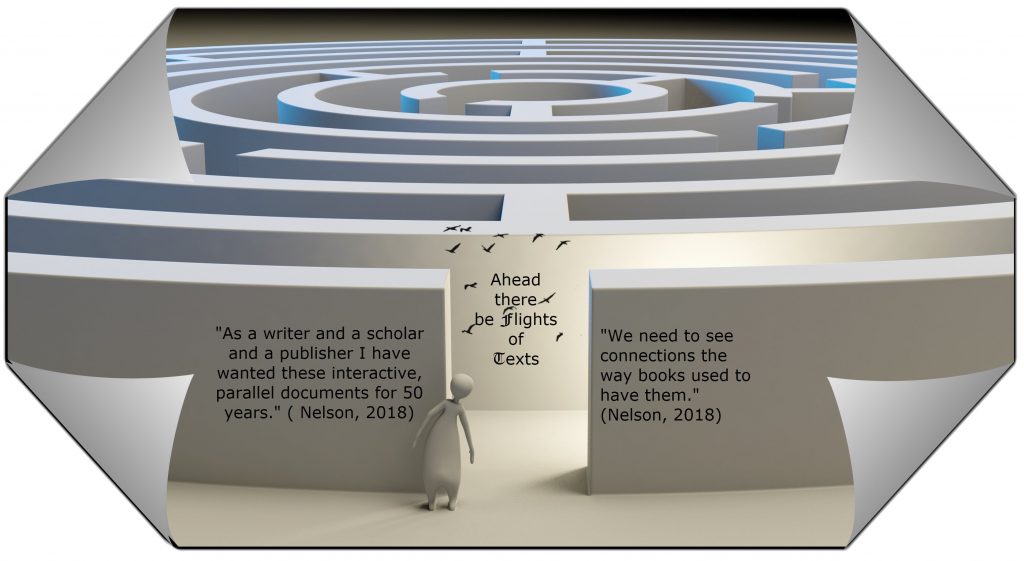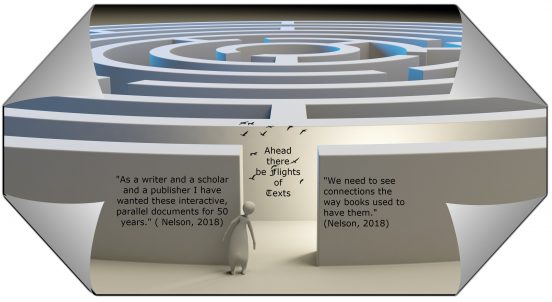
Last year, my dad was honestly (and astonishingly) upset when President’s Choice changed their rewards card program. A few years ago, my brother-in-law filled a deep freezer with the McCain’s pizza pockets because the original recipe was discontinued…. People don’t like change, even when it’s a relatively minor inconvenience, and certainly not when it affects the entire cognitive process for communication. Because linear texts have been a part of our cultural history for thousands of years, I’m not surprised that digital writing technology continues to mimic paper.
In 1945, Vandevar Bush stated that “It is strange that the inventors of universal languages have not seized upon the idea of producing one which better fitted the technique for transmitting and recording speech.” (Bush, 1945) Almost 50 years later David Bolter wondered whether traditional, linear text structure might be remediated by hypertexts or hypermedia that better reflects the associative nature of the human thinking. (Bolter, 2000, p. 26)
I am fascinated by Ted Nelson’s criticism that the web was created to mimic paper. (Nelson, 2007) In a recent video Nelson talks about “…connected parallel texts” that could “…loosen the paradigm of sequenced texts.” (TheTedNelson, 2018) He emphasizes the importance of “visible connections” and proposes the concept of “flights of documents”. It’s difficult to fully grasp what he’s describing because it’s fundamentally different than merely “jumping” from one text document to another; it’s fundamentally different from digitally recreating paper.
If associative thinking and the freedom to navigate a text in multiple ways is “more natural” then perhaps the persistence of linear texts is less preference and more impulse to resist change. Part of the change has a distinctly constructivist vibe, suggesting that “…hypertext is a process, as much as a product…” (Bolter, 2000, p. 27) that requires you to pay attention and make decisions.
I am reminded of two things. The first is “choose your own way adventure stories” which allow you to make decisions at the end of each chapter and turn to a different page depending on what you decide. In my youth, I would re-read these books until I was satisfied that I had discovered every possible outcome. I loved them! By comparison, the internet is a far more nebulous ‘choose your own way adventure’, and you can quickly find yourself far adrift from your original path.
The second thing I am reminded of is Von Glaserfeld’s constructivist explanation of how we attach abstract meaning to words based on our subjective experiences in the world. The idea that words are not just “…containers in which the writer or speaker convey meaning to readers or listeners.” (Glasersfeld, 2008, p. 39) but instead we construct the meaning of those words. The dynamic, active nature of hypertexts seems to align with constructivist epistemology.
In the world of active construction and nebulous texts, the importance of “visible connections” begin to make more sense. If the very infrastructure of the web allowed more permanence and traceability this would be a powerful tool for navigation and production. Perhaps this would be a world where tedious referencing rules could be forgotten, and recursive, active remix processes would be accepted as the newfangled forms of creativity and learning.
References
Bolter, D. (2000). Writing Space: Computers, Hypertext and Remediation of print. New York and London: Routledge.
Bush, V. (1945). As We May Think. The Atlantic Monthly, 176(1), 101-108. Retrieved from https://www.theatlantic.com/magazine/archive/1945/07/as-we-may-think/303881/
Glasersfeld, E. V. (2008). Learning as a Constructivist Activity. AntiMatters, 2(3), 33-49.
Nelson, T. (2007, January 29). Transclusion: Fixing electronic literature. Retrieved from YouTube: https://www.youtube.com/watch?v=Q9kAW8qeays
TheTedNelson. (2018, April 13). Xanadu Basics 1a: VISIBLE CONNECTIONS. Retrieved from YouTube: https://www.youtube.com/watch?v=hMKy52Intac



Cathy Miyagi
July 17, 2018 — 11:21 pm
I love your reference to the Choose Your Own Adventure books! This may be beyond the scope of this course, but I wonder if the evolution of hypertext and the disruption to linear text are also playing out in another form of entertainment: immersive or interactive theatre.
Speak No More is a modern twist on Shakespeare’s Macbeth set in a 1930’s era “McKittrick Hotel” in New York’s Chelsea neighborhood. The show takes place in a warehouse housing multiple rooms, floors, and stairwells.
The show is noted to have 27 hours worth of material, which makes the audience’s experience like a snowflake; There just can’t be two of the same. Even superfans – who go watch the show multiple times – collect vast catalogs of knowledge about the show in its endless possible permutations (Burton).
This interactive narrative follows a fractal structure (Miller 125) whereby the story expands and grows scope depending on where physically the viewer chooses to be. This allows for the actors to repeat scenes too, as the participant/viewer has likely moved on to another location of the McKittrick Hotel.
Sleep No More also exhibits a branching structure or “cul-de-sacs” (Miller 124) whereby the viewer is free to explore different areas, and follow different characters but they remain walled in the room.
Because the story follows that of Macbeth, the play has the traditional beginning, middle, and end – but it’s based on things the viewer must experience to make his/her own narrative. The story has an ultimate destination or ending but it doesn’t push the participant towards it. You can choose to follow just one character, therefore honing on his/her own sub-story or see things from their POV. You can even repeat scenes by returning to the same scenes. You may see a character whiz by you in an adjacent room followed by a herd of other viewers, and you might then feel inclined to skip scenes.
The “loss” to this type of new entertainment is that the audience can get so caught up in the immersive theatrical experience, that they may lose the story altogether. Some critics may even argue that it’s not even interactive; Although the viewer has control over how long they want to stay at a particular scene, move from one to another in sporadic order, and touch & feel props in the room, they cannot interact with the actors themselves and therefore have no bearing on the story.
References:
Burton, Tara. “Losing Sleep with the Superfans of Sleep No More.” Narratively, 2015, http://narrative.ly/losing-sleep-with-the-superfans-of-sleep-no-more/. Accessed 17 July 2018.
Miller, Carolyn H. Digital Storytelling: A Creator’s Guide to Interactive Entertainment. Elsevier, 2004.
sally bourque
July 30, 2018 — 8:27 am
Hi Cathy,
Thanks for replying! I started replying so many days ago and it just never got posted!
That immersive theatre experience sounds FASCINATING! It’s also a perfect connection to the concept of hypertexts and how we like to experience stories. As I think about the experience, I’m both fascinated and intimidated. I’m comfortable as a passive reader and watcher. It’s something I choose to do to unwind and relax. Even if I sit on the couch and check my phone to relax I tend to choose things that are mindless scrolling and don’t involve a lot of decision making or searching.
I think Mackenzie (below) is onto something in suggesting that the medium ( internet vs. theatre vs. reading vs. oral story telling) seems to fulfill different information sharing and finding requirements. (The medium is the message, I suppose) As per Bolter (p. 26, 27, 40, ) I have been wondering what a “more natural” form of text means. Bolter suggests that “…because fiction is still understood as a remediation of printed fiction, the constant violations of order are read as attempts to undermine the method of story-telling that the tradition of print appears to sanction.” (Bolter, p. 64)
Linear story-lines are just easier to follow…at least, having grown up in a linear dominant culture it is easier for me, but some of the articles we’ve read this module ask whether the next generation will become more and more comfortable with non-linear stories, and knowledge consumption. As Mackenzie mentions below, sandbox games are another example to parallel with hypertext or even (perhaps) the open-mode theater experience you’ve described, yet those games only appeal to some gamers. Linear story lines in games persist, just as linear stories, theater and websites likely will continue to persist.
As I’m thinking about the way I tend to engage with texts, I think some significant changes need to happen in society before non-linear texts would be preferred over traditional linear simply because when the the work-week and day are long, many of us are too exhausted to want to engage with something non-linear. This is, perhaps, why recognizing the advantages and (relatively?) slow proliferation and up-take of new texts occurs; our society just isn’t structured to allow the average person to engage, enjoy and recognize new ways to use these kinds of texts and visual technologies.
mackenzie moyer
July 26, 2018 — 7:10 pm
Thanks for the post and thanks for reminding me of Glasersfeld! I need to reread this article—it really made an impression on me. Pertaining to how this connects to Nelson and Bolter, you’ve illuminated something for me. I found both of these authors enticing as I read, but upon reflection I asked myself “Then why isn’t it so?” In the case of Bolter, he argues that print will be taken over by hypertext and the kinds of “choose your own way” adventure stories that we remember from our youth (incidentally, I use “choose your own way” scenario-based learning in work projects).
In Glaserfeld’s terms, what are we doing when we read a story? Since ideas are not conveyed by words, but instead embody that meaning in a subjective experienced way, we’re constructing a reality aided by the medium of a book.
When we read, we imagine, and the more words from a book that interfere with that processes through sheer verbiage, the less enjoyable stories can sometimes become. I think Bolter, then, is confusing the mechanism of the reader choosing the story for the point of a story: since the dawn of time, people have provided stories. Yes, oral cultures allowed the crowd to interject, but it wasn’t as though the listeners chose what the heroes in epics were going to do.
I’m also reminded of my younger sister and cousins: they’d want the same movies and books, over and over and over again. I must admit, there are some personal favourites where I’ve done this myself. There’s just something about a really good story, one designed to touch the very essence of this or that aspect of human nature, that we love: the characters with their strengths and weaknesses, the tension, the etc.
I’ve played a lot of video games in my time, and the type of writing that Bolter envisions sounds a lot like “sand-box” games (e.g., Grand Theft Auto). Video games are a separate medium from the written word, to be sure, but there are two relevant aspects about sand-box games worth considering in our context. First, sand-box style games haven’t completely taken over every other genre, and linear games still exist. If the fact that people can choose is alone to take us from present text to Bolter’s vision…it hasn’t worked with video-games (a very perfect medium to execute Bolter’s vision…and all that visual-anti-text too!!).
Second, the fact that videogames exist alongside a (still growing) paper-book publishing company tells us that the mediums coexist and offer something different. This second aspect may have something to do with why videogames (a visual—but also multi-modal/experiential—based medium) have taken on branching-style narratives, while interactive books—even interactive video!—have been lackluster in these areas.
For me, Nelson’s claims follow the same trajectory: they don’t get why people use the net. Coming back to Glasersfeld, we construct meaning from experience. Typically, no one tells us the meaning of a hashtag or meme—there certainly is no underlying, centralized, abstract infrastructure, with permanent and visual links. Instead, we…experience the meme or hashtag and we see patterns of them around us; the meaning of these linkages emerges from experience.
Combining experiences on the net with Bolter and Nelson, I maybe should have started with this point: imagine the amount of work it would take to do what they’re both saying. Would all that work be worth it? Would it be worth it to have 50 Shades of Gray written in uber-hyper-text with links that never break, so that 50 years down the road when you’re several shades greyer you can track your past thoughts on the book and how those connect to the present? I can’t even keep track of my history or clean out my inbox. I just…I can’t imagine the clutter, lol.
“’…hypertext is a process, as much as a product…’ (Bolter, 2000, p. 27) that requires you to pay attention and make decisions.” I really like this quote, there’s so much to link this to! I think the most immediate thing that comes to mind is that Bolter’s claim and your reflection work very well when applied to technology.
Although I could continue sharing the internal dialogue going on at the moment, I highly doubt anyone will read this…which reminds me of Cathy’s post: “As a student in our Canadian high school system, I recall long nights of studying while feeling overwhelmed at the amount of information I had to take in. I get the impression that students now can be overwhelmed with their inability to filter information out.”
I just hypertexted this course.
Good night,
Mackenzie
mackenzie moyer
July 26, 2018 — 7:13 pm
PS: here’s the super Academic reference to Cathy’s post (the hyperlink got deleted in the transfer from Word to WordPress):
https://blogs.ubc.ca/etec540summer2018/2018/07/17/muds-and-moos/
sally bourque
July 30, 2018 — 9:34 am
Hi Mackenzie!
Thank you for the long response. I can see a like-minded thinker in the way your ideas unfold. I love it!
Please see above response to Cathy too, I’ve also referenced some of your ideas responding to her.
I am particularly struck by ” instead, we…experience the meme or hashtag and we see patterns of them around us; the meaning of these linkages emerges from experience.” This is a very Glaserfeld/constructivist interpretation of meaning making.
Also, I know what you mean about imagining the amount of work it would take to build the net the way Nelson and Bolter suggest. I take your point about the way the net is used now, but I can’t help but wonder if Nelson is one of those thinkers able to imagine something so drastically different that it’s just really difficult for the rest of us to comprehend how it would revolutionize the way the net operates and hence could be used.
I agree, the massive versioning of digital objects seems somewhat useless to me, but perhaps there are advantages to a well structured permanence in the digital realm. It certainly seems that one of the defining features of current web is lack of permanence (somewhat) and so, we use it with that in mind.
Interesting point about video games existing alongside paper book publishing, and even e-book publishing. The technology behind video games has improved significantly in a short amount of time. I’m 34 and I remember having the first nintendo system as a kid, fast forward to today and I have a nintendo switch with games that would blow my past-self’s mind! 20 short years and games have advanced so much. There weren’t many adults playing video games when I was growing up, but I have adult friends now who invest much more time and money in gaming systems than books. I think games have just begun to compete with more traditional texts, in many ways. It reminds me of the new(ish) movie “Ready Player One” where significant virtual worlds exist. I think we are coming close to living in that world; I may even get to see it! (fingers crossed) and that world has the potential to turn the world of text and multi-literacy on it’s head! Again though, as with the technology we have today, I feel like it will continue to “reproduce paper” and copy the real world for many generations before anything “radical” emerges.